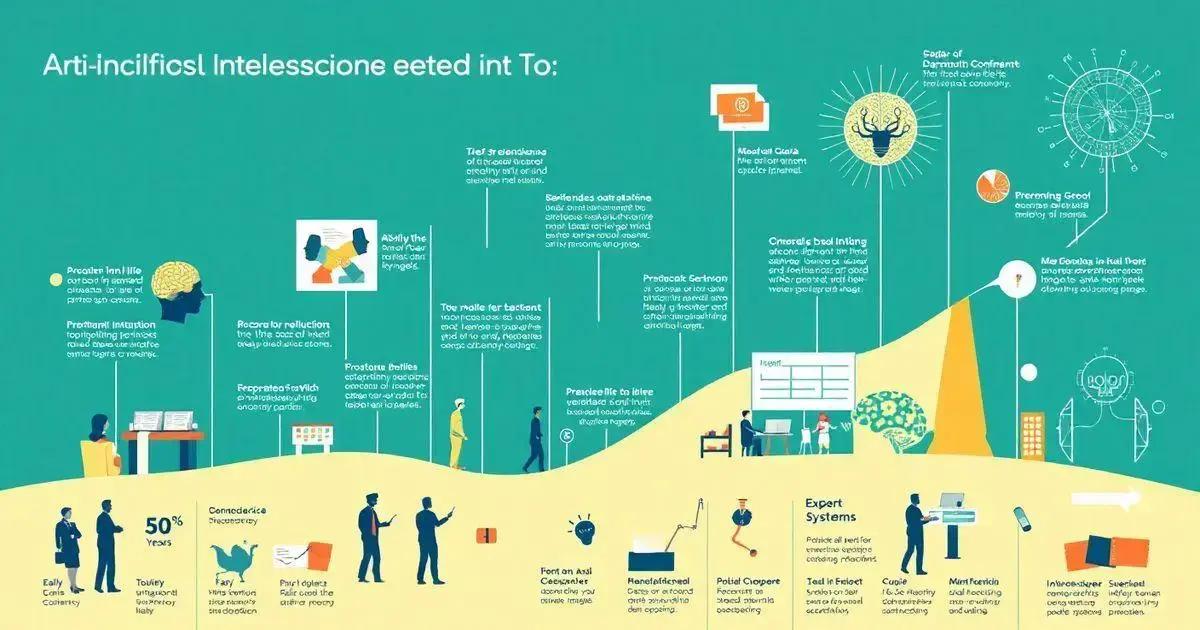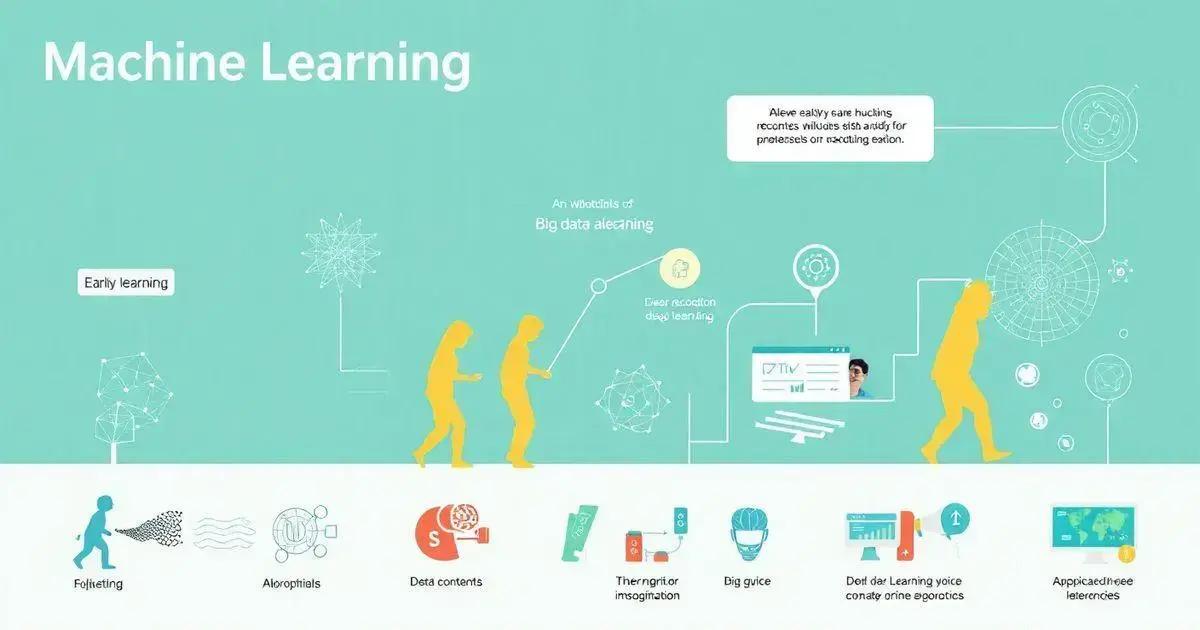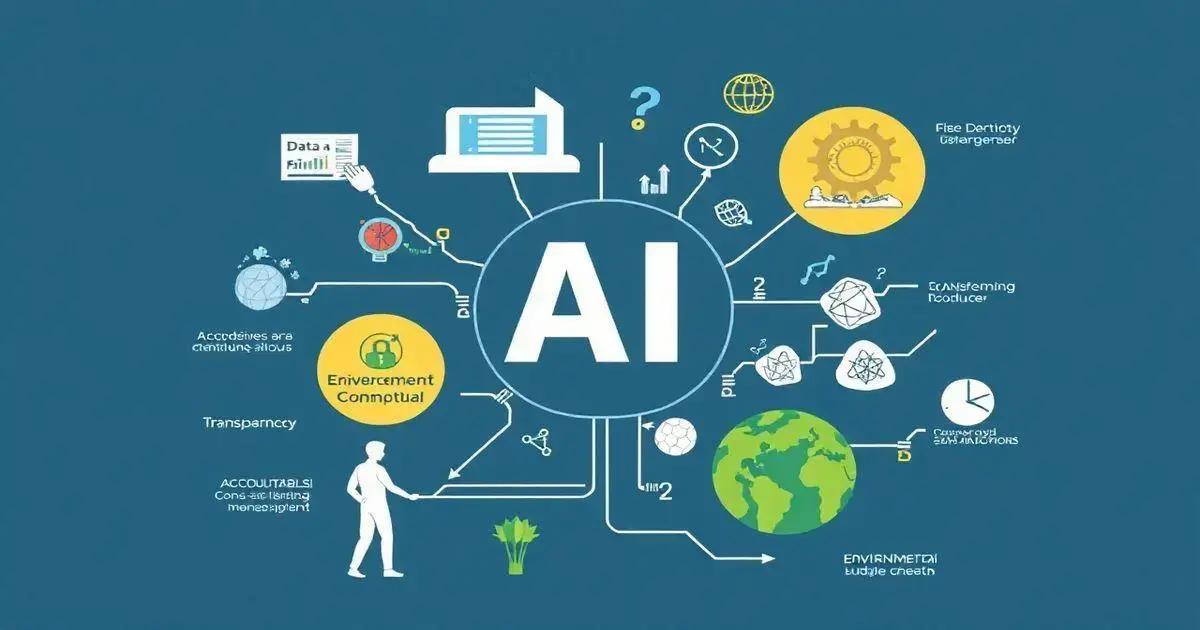50 years of artificial intelligence have dramatically transformed how we interact with technology.
From the early days of simple algorithms to today’s advanced machine learning systems, AI has evolved to solve real-world problems and push the boundaries of innovation.
This article takes you on a journey to explore the significant milestones and impacts of AI across various industries. We will also consider future trends and the ethical implications that come with this powerful technology.
The Origins of Artificial Intelligence
The origins of artificial intelligence (AI) date back to the mid-20th century. In 1956, a group of researchers, including John McCarthy, Marvin Minsky, and Allen Newell, gathered at Dartmouth College to discuss creating machines that could simulate human intelligence. This conference is often considered the birthplace of AI.
The Early Concepts
Before AI was a formal field, early thinkers like Alan Turing laid the groundwork. Turing posed the question, “Can machines think?” He introduced the Turing Test, which determines if a machine’s behavior is indistinguishable from a human’s.
Pioneering Programs
In the following years, several early AI programs emerged. In 1951, Christopher Strachey developed a checkers program that could play well against human opponents. Meanwhile, Alan Newell and Herbert A. Simon created the Logic Theorist in 1955, capable of solving mathematical problems.
The Rise of AI Research
As the interest in AI grew, so did investment in research. Governments and institutions began to fund AI projects, viewing them as essential for future technological advancements. AI research diversified into numerous fields, including natural language processing, robotics, and computer vision.
Challenges in the Early Days
Despite early enthusiasm, researchers faced many challenges. The technology at the time was limited, and expectations often exceeded what was possible. This led to periods known as “AI winters,” where funding and interest waned significantly.
Rebirth of AI in the 1980s
The 1980s saw a resurgence in AI research with the development of expert systems, programs designed to mimic human decision-making. These systems found applications in industries such as healthcare and finance, solidifying AI’s role as a powerful tool.
Throughout its origins, artificial intelligence has evolved significantly, laying the foundation for the remarkable advancements we see today. As we celebrate 50 years of artificial intelligence, it’s essential to acknowledge the vision and persistence of those early pioneers.
Major Milestones in AI Over 50 Years

Over the past 50 years, artificial intelligence has achieved several major milestones that have shaped its current landscape. These milestones represent significant advancements in technology and have established AI as a cornerstone of modern innovation.
1. The Dartmouth Conference (1956)
In 1956, the Dartmouth Conference marked the official birth of AI as a field. Scholars set out to explore the potential of machines to simulate human intelligence. This event laid the groundwork for AI research for decades.
2. The First AI Programs (1950s-1960s)
During the late 1950s and 1960s, pioneering programs such as the Logic Theorist and General Problem Solver were developed. These programs demonstrated the capability of machines to solve complex problems through logical reasoning.
3. Expert Systems (1970s-1980s)
The rise of expert systems in the 1970s represented a shift in AI focus. These systems were designed to mimic the decision-making abilities of human experts in fields like medicine and finance, leading to practical applications that showcased AI’s potential.
4. The AI Winter (1970s-1980s)
Despite early successes, the field faced setbacks during the AI winter, a period characterized by reduced funding and interest due to unmet expectations and difficulties in AI development. This era lasted from the late 1970s to the early 1990s.
5. Machine Learning Revolution (1990s)
The 1990s marked the beginning of a new era with the resurgence of AI due to advancements in machine learning. Algorithms became more sophisticated, allowing computers to learn from data and improve over time. This shift opened new possibilities for AI applications.
6. AI in Everyday Life (2000s-Present)
In the 2000s, AI began to integrate into everyday life with the advent of technologies like smart assistants, recommendation systems, and autonomous vehicles. Today, AI powers numerous applications across various sectors, making it an essential part of modern technology.
As we reflect on these major milestones, it’s evident that each achievement has built a strong foundation for continued innovation in artificial intelligence, paving the way for future advancements.
Impact of AI on Various Industries
The impact of artificial intelligence (AI) on various industries over the past 50 years has been profound. This technology has changed how businesses operate and interact with customers, leading to new efficiencies and innovations.
Healthcare
In the healthcare industry, AI is revolutionizing diagnostics and patient care. AI algorithms analyze medical images to detect diseases like cancer earlier and more accurately than human doctors. Virtual health assistants use AI to manage appointments and provide patients with reliable information about their health.
Finance
The finance sector benefits heavily from AI through fraud detection and algorithmic trading. Banks use AI to monitor transactions in real-time and identify unusual patterns that may indicate fraud. Additionally, AI algorithms analyze market trends to inform trading strategies, increasing profitability.
Retail
In retail, AI enhances customer experiences through personalization and efficient inventory management. E-commerce platforms utilize AI to recommend products based on browsing history, increasing sales. AI also helps retailers manage inventory levels to meet consumer demand without overstocking.
Manufacturing
Manufacturing industries have adopted AI to optimize production processes. Robotics powered by AI perform repetitive tasks with high precision, reducing errors and increasing efficiency. Predictive maintenance uses AI to predict when machines will fail, allowing companies to minimize downtime and repair costs.
Transportation
AI has transformed transportation, especially with the rise of autonomous vehicles. These vehicles use AI to navigate, recognize obstacles, and make decisions in real-time, promising safer roads. AI also plays a role in route optimization for logistics companies, saving time and fuel costs.
Education
In education, AI personalizes learning experiences by adapting to individual student needs. AI tools help identify students who struggle, enabling educators to provide targeted support. Furthermore, AI can automate administrative tasks, freeing up educators to focus more on teaching.
The influence of AI changes how industries operate, bringing forth new opportunities and enhanced efficiency. As AI technology continues to evolve, its impact across various sectors is likely to grow even further, shaping the future.
The Evolution of Machine Learning

The evolution of machine learning has been a vital part of the progress in artificial intelligence over the past 50 years. Initially, machine learning focused on creating algorithms that allowed computers to learn from data without explicit programming.
Early Concepts
In the 1980s, researchers began using basic algorithms that enabled computers to learn based on input data. The most used method at the time was decision trees, which helped classify data into categories. However, these initial systems were limited in their capabilities.
Rise of Neural Networks
The 1990s introduced the concept of neural networks, inspired by the human brain’s structure. Neural networks allowed computers to process complex data patterns, such as images and audio. This shift led to breakthroughs in recognizing handwritten digits, voice commands, and much more.
Big Data and Advancements
With the emergence of the internet and the ability to collect massive amounts of data, machine learning entered a new era in the 2000s. Researchers began utilizing big data to train models more effectively, improving their accuracy and performance. This period also marked the rise of supervised and unsupervised learning techniques.
Deep Learning Breakthroughs
In the 2010s, deep learning revolutionized machine learning. Deep learning utilizes multi-layered neural networks to learn from vast amounts of unstructured data. Applications such as image recognition and natural language processing became more accurate and efficient, sparking interest across various industries.
Machine Learning Today
Today, machine learning is integrated into many everyday applications, from recommendation systems in e-commerce to virtual assistants like Siri and Alexa. As businesses continue to explore its potential, machine learning remains at the cutting edge of AI research.
The journey of machine learning illustrates its transformative capability. With ongoing advancements, it will further redefine how we interact with technology and the world around us.
Future Trends in Artificial Intelligence
As we look ahead, several future trends in artificial intelligence are emerging that will shape the technology’s development and integration into our daily lives. These trends promise to enhance capabilities and address ongoing challenges in AI.
1. Increased Automation
Automation will continue to expand across various industries. From manufacturing to healthcare, AI will take over repetitive tasks, allowing humans to focus on more complex and creative work. This shift will improve efficiency and productivity in businesses.
2. Improved Natural Language Processing
Natural language processing (NLP) is expected to see significant advancements. Future AI systems will better understand and generate human language, facilitating more fluid interactions with virtual assistants and chatbots. This trend will enhance customer service and accessibility.
3. Ethical AI and Responsibility
With the growing reliance on AI, the need for ethical guidelines is becoming crucial. Companies and governments will prioritize developing responsible AI systems that prevent bias and ensure data privacy. Regulations and frameworks will be established to guide ethical practices in AI development.
4. AI-Driven Personalization
Personalization powered by AI will revolutionize consumer experiences. Businesses will leverage machine learning to create highly tailored services and products, anticipating user preferences and behaviors. This personalization will lead to increased customer satisfaction and loyalty.
5. Enhanced AI Accessibility
AI technology is expected to become more accessible to smaller businesses and individuals. Open-source platforms and user-friendly tools will enable more people to harness AI’s power, fostering innovation across various sectors and driving economic growth.
6. Integration of AI with IoT
The combination of AI and the Internet of Things (IoT) will allow for smarter systems and environments. Connected devices will use AI to analyze data in real time, optimizing operations in domains such as smart cities, agriculture, and environmental monitoring. This integration will enhance decision-making and resource management.
The future of artificial intelligence promises to be transformative, impacting various aspects of society. By staying aware of these trends, individuals and businesses can prepare for a world increasingly shaped by AI technology.
Ethical Considerations in AI Development

As artificial intelligence (AI) continues to grow, ethical considerations become increasingly important in its development. Addressing these concerns is crucial to ensure that AI technology benefits society as a whole.
1. Data Privacy
One of the primary ethical concerns in AI is data privacy. AI systems often rely on large datasets to learn and make decisions. It is vital to handle personal information responsibly and implement strong security measures to protect users’ data from breaches and misuse.
2. Bias and Fairness
AI can unintentionally perpetuate biases present in its training data. This can lead to unfair treatment of individuals based on race, gender, or socioeconomic status. Developers must prioritize fairness in AI algorithms by auditing datasets for bias and ensuring diverse and representative data is used.
3. Transparency
Transparency in AI processes is essential for fostering trust. Users should understand how algorithms make decisions, especially in critical areas like healthcare or criminal justice. Developing AI systems that are explainable can help demystify their functioning and build public confidence.
4. Accountability
If AI systems cause harm or make mistakes, accountability can be complicated. It is essential to establish clear guidelines on who is responsible for AI outcomes. Companies should implement measures that ensure accountability in both development and deployment stages.
5. Job Displacement
The rise of AI may lead to job displacement for many workers, especially in industries that rely heavily on automation. Ethical AI development should include strategies for reskilling and upskilling the workforce to adapt to changes in job roles and responsibilities brought about by AI.
6. Environmental Impact
Moreover, the environmental impact of AI cannot be overlooked. Training powerful AI models requires significant computational resources, leading to high energy consumption. Developers should strive for sustainable AI practices that minimize energy use and environmental footprint.
By prioritizing these ethical considerations, researchers, developers, and organizations can ensure that AI technology advances responsibly. This commitment to ethics will help build a future where AI serves humanity positively and equitably.
50 Years of Artificial Intelligence: Final Considerations
Over the past 50 years, artificial intelligence has evolved dramatically, impacting various industries and reshaping our world. As we have explored, AI’s origins and major milestones laid the foundation for its current capabilities, while the evolution of machine learning has driven innovation.
The impact of AI is seen across sectors such as healthcare, finance, and transportation, where it enhances productivity and improves decision-making. Looking to the future, trends indicate further advancements in automation, natural language processing, and ethical considerations that must guide AI’s development.
As we embrace the potential of AI, it is essential to prioritize ethical considerations to ensure that technology positively influences society. By addressing issues of data privacy, bias, accountability, and environmental impact, we can foster a responsible approach to AI development.
Ultimately, AI holds great promise for our future, enabling new opportunities and experiences that were once unimaginable. Embracing this technology with care will unlock its full potential and lead to a better tomorrow.